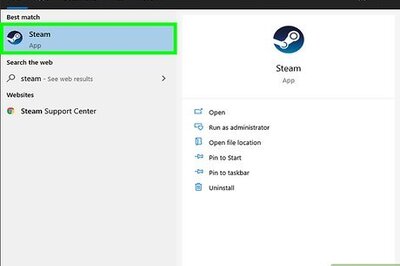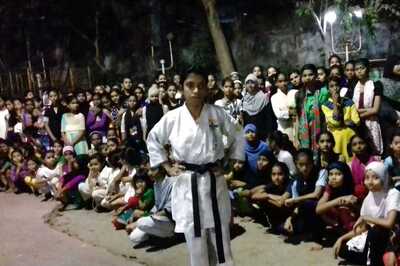
views
New Delhi: Many Indian parents choose government schools for girls in the age group of 4 to 8 years while they favour private schools for boys, according to the latest edition of the Annual Status of Education Report (ASER), indicating that gender gaps are apparent even among young children.
ASER 2019, released on Tuesday, focuses on the ‘early years’. It throws light on the patterns of pre-school and school enrolment of children in the 4-8 age bracket. ASER is India’s largest NGO-run annual survey, conducted by the non-profit Pratham since 2005 to evaluate the relevance and impact of its programmes.
The data shows that performance on cognitive, early language, early numeracy, and social and emotional development tasks is closely related to children’s age, with older children doing better than younger ones. “Permitting underage children into primary grades puts them at a learning disadvantage which is difficult to overcome,” says the report.
More than 90% of children enrolled
The key findings show “more than 90% of children in the 4-8 age group are enrolled in some type of educational institution. This proportion increases with age, from 91.3% of all 4-year-olds to 99.5% of all 8-year-olds in sampled districts”.
However, the report pointed out that young children of the same age vary enormously in terms of where they are enrolled. For instance, at the age of 5, 70% of the children are in anganwadis or pre-primary classes. On the other hand, 21.6% children are already enrolled in class I at that age. Further, at the age of 6, 32.8% children are in anganwadis or pre-primary classes, while 46.4% are in class I, and 18.7% class II or higher.
The report reveals that the anganwadis cater to large a section of children well before they enter pre-primary classes. “The already significant scale of this network can be leveraged to reach those children who remain unreached. At the same time, the ability of these centres to implement appropriate school readiness activities for 3 and 4-year-olds needs to be strengthened,” says the report on policy-level implications.
Enrolment patterns show more girls in government schools
The report also reveals that even at this young age, enrolment patterns are different for boys and girls. A higher proportion of girls are enrolled in government institutions and a higher proportion of boys in private institutions.
The difference is seen to grow larger as children get older. For example, among 4 and 5-year-old children, 56.8% girls and 50.4% boys are enrolled in government pre-schools or schools, while 43.2% girls and 49.6% boys are enrolled in private pre-schools or schools. For 6 to 8-year-olds, 61.1% of girls versus 52.1% of boys go to a government institution.
The early years, defined globally as age 0-8, are known to be the most important stage of cognitive, motor, social and emotional development in the human life cycle.
The survey was conducted in 26 districts across 24 states in India, covering a total of 1,514 villages, 30,425 households, and 36,930 children in the age group of 4-8 years.
The sampled children’s enrolment status in pre-school or school was collected. Children did a variety of cognitive, early language, and early numeracy tasks; and activities to assess the children’s social and emotional development were also undertaken.
All tasks were done one-on-one with children in their homes.
At age 5, location matters
This is the age children should be encouraged to develop a range of abilities and skills, including cognitive, social and emotional skills as well as the conceptual foundations needed for formal schooling.
The survey points out what a 5-year-old is doing depends largely on where he or she lives. It all hinges on state norms for entry to school. So what we see is Thrissur, Kerala records 89.9% of 5-year-olds attending a pre-primary class and almost all the rest studying in class I. As we move to East Khasi Hills, Meghalaya, there are just 65.8% children of the age group in pre-school, while 9.8% are in class I, and 16% in class II. On the other hand, in Satna, Madhya Pradesh, 47.7% are in pre-school, 40.5% are in class I, and 4.1% are in class II.
The survey further underscores that regardless of whether or where students are enrolled, young children’s ability to do cognitive, early language, early numeracy, and social and emotional learning tasks is higher among 5-year-olds than among 4-year-olds. For instance, 31% of 4-year-olds enrolled in anganwadis or government pre-primary classes were able to do a four-piece puzzle, while 45% of 5-year-olds attending these institutions could do so.
Young and disadvantaged
It is expected that at age 5, children should be able to do most of the cognitive tasks with ease. However, a large proportion is unable to do so and it is basically because of the family background. The report states, “Children from less advantaged homes are disproportionately affected. Although almost half of all 4-year-olds and more than a quarter of all 5-year-olds are enrolled in anganwadis, these children have far lower levels of cognitive skill and foundational ability than their counterparts in private LKG/UKG classes.”
The reason being given is these are young children who spend much of their time at home, and these differences in outcomes may be driven mainly by children’s home characteristics.
The report highlights that among the pre-primary section, children with mothers who completed eight or fewer years of schooling are more likely to be attending anganwadis or government pre-primary classes. “Whereas their peers whose mothers studied beyond the elementary stage are more likely to be enrolled in private LKG/UKG classes.”
ASER data shows that children’s performance on tasks requiring cognitive skills is strongly related to their ability to do early language tasks and early numeracy tasks.
This suggests that focusing on play-based activities that build memory, reasoning, and problem-solving abilities is more productive than an early focus on content knowledge.
Overall, 41.7% of children in class I are of the RTE-mandated age
The Right to Education Act, 2009 (RTE) mandates that children should enter class I at age 6. Many states allow entry to class I at age 5+. However, 4 out of every 10 children in class I are younger than 5 or older than 6. The report says, “Overall, 41.7% of children in standard I are of the RTE-mandated age of 6 years, 36.4% are 7 or 8 years old, and 21.9% are 4 or 5 years old.”
The survey throws light on the fact that “within the standard I cohort, almost no children age 4 and 5 can read a standard I level text. This proportion increases steadily with age.”
Children's performance on cognitive, early language, early numeracy, and social and emotional learning tasks is strongly related to their age. Older children do better on all tasks.
The class I students studying public-private schools
The children studying in class I of government schools are younger than those in the same level in private schools, suggests the report. It highlights that more than a quarter of class I students in government schools are either 4 or 5 years old at 26.1%, while the corresponding proportion for private schools is ten percentage points lower at 15.7%.
On the other hand, 30.4% students in class I in government schools are 7-8 years old, while this proportion in private schools is far higher at 45.4%. As was seen among the 4 and 5-year-olds, a clear relationship is visible between children's cognitive skills and their ability to do early language and early numeracy tasks in class I. The children in class I who could do three cognitive tasks correctly had higher reading ability and were also more likely to solve oral word problems than their peers who could not.
Older students do better than younger ones
The findings from ASER show that the variation in age distribution within each class is widest in class I and decreases in each subsequent class. “But older children continue to do better than younger ones on every ASER task.”
The report has cited that while most children in class III in both government and private schools are either 7 or 8 years old, 53.4% of 8-year-olds in class III could read a class I level text, while only 46.1% of 7-year-olds could do so.
Children’s skills and abilities improve in each subsequent class. As per the report, “children’s ability to read standard I level text improves from 16.2% of children in standard I to 50.8% children in standard III. This means that half of all children in standard III are already at least two years behind where the curriculum expects them to be.”
Similarly, 41.1% of students in class I can recognise two-digit numbers, while 72.2% of students in class III can do so. But according to NCERT's specification of learning outcomes, children are expected to be able to recognise numbers up to 99 in class I itself.
As before, there is a strong relationship between children's cognitive skills and their performance on early language and early numeracy tasks. “In standard III, 63.2% of children who did all 3 cognitive tasks correctly were able to read at standard I level, as compared to 19.9% of children who were able to do one or none of the cognitive tasks correctly.”
The report concludes saying that ASER 2019 ‘early years’ data shows a clear relationship between children’s performance on cognitive tasks and measures of early language and early numeracy, suggesting that a focus on activities that strengthen cognitive skills rather than subject learning in the early years may generate substantial benefits in terms of children’s future learning.
“The entire age band from 4 to 8 needs to be seen as a continuum, and curriculum progression across grades and schooling stages designed accordingly,” it says. “For an effective and implementable curriculum, the process of designing, planning, piloting, and finalizing needs to keep ground realities in mind.”




















Comments
0 comment